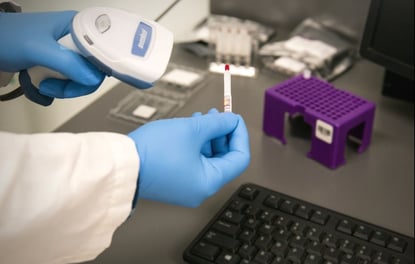Share this
using Mitra to solve sample extraction, stability & hematrocrit biases
by James Rudge, PhD, Technical Director, Trajan on Dec 13, 2021 9:00:00 AM
 An article published by Iris Xie, Yang Xu and Kevin Bateman et al in the April 2018 issue of the Journal of Pharmaceutical and Biomedical Analysis, reported on the importance of developing robust extraction methods from samples collected with Mitra® devices to avoid extraction mediated biases.
An article published by Iris Xie, Yang Xu and Kevin Bateman et al in the April 2018 issue of the Journal of Pharmaceutical and Biomedical Analysis, reported on the importance of developing robust extraction methods from samples collected with Mitra® devices to avoid extraction mediated biases.
The paper is entitled “Extractability-mediated stability bias and hematocrit impact: High extraction recovery is critical to feasibility of volumetric adsorptive microsampling in regulated bioanalysis.” It describes the development and optimization of the extraction methodology for two small drug molecules, raltegravir and sitagliptin. Due to differences in the relative hydrophobicities of the two drugs, different extraction approaches were employed.
Biases Seen with Dried Blood Samples
There are several biases to be considered when working with dried blood, teasing out and compensating for the different types of bias from dried blood spot (DBS) samples, including extraction related to hematocrit (HCT) bias. This was elegantly demonstrated in an earlier paper published in Analytical Chemistry (2013) by Paul Abu-Rabie et al.
When Mitra devices with VAMS® technology were launched in 2014, their volumetric approach to sample collection eliminated both spot migration and spot punch location biases that had been observed with DBS. Furthermore, it was demonstrated that Mitra devices could collect a fixed amount of blood independent of %HCT. As a result, when working with samples and standards in blood, only two main biases would need to be considered. The first bias to consider is from any matrix effects, and the second is HCT bias from a potentially incomplete extraction, which could also be affected by the age of the sample.
Sample Extraction Biases Examined
The paper by Xie, Xu and Bateman et al reviewed here highlighted an observation in the early Mitra-VAMS manuscripts that reported extraction biases for several analytes across a wide HCT range. Indeed, several manuscripts highlighted the importance of optimizing extraction methodology to minimize or eliminate this effect. The authors noted that a number of early studies reported an apparent compound instability over several days of storage. Although compound stability is always something to evaluate when developing analytical methods, it is known that many analytes are stable in dried blood, certainly in the medium term.
Xie, Xu and Bateman et al thus hypothesized that there could be a temporal bias factor to consider with dried blood, which could then be misinterpreted as instability for some compounds. They called it “extractability-mediated stability bias.” We will call it “temporal bias.” In short, temporal bias happens when blood ages and analytes become progressively entrapped in the dried hematocrit, leading to negative biases over time.
The lower the extraction efficiency and the wider the %HCT range, the worse the bias becomes. The reason for this is still unknown, but we do know of many physicochemical changes when blood dries.
One such change is that hemoglobin forms a dimer, which may contribute to this phenomenon. The good news is that we now know how to control for this by optimizing extraction methodology—a solution resulting from research conducted on this phenomenon, such as the work highlighted in this blog.
Object of the Study
The authors wanted to demonstrate that optimizing the extraction efficiency on dried samples and aged dried samples would help to mitigate both %HCT bias and the related temporal bias effect.
Sample Extraction Study Methods & Findings
The researchers explored and optimized extraction methodologies of two drugs: raltegravir and the more hydrophilic molecule, sitagliptin.
- For both analytes, EDTA blood samples (25-45% %HCT) were prepared.
- Separate calibration curves for each drug were prepared in 45% HCT blood on Mitra.
- Low and High QC samples were prepared in the 25-65% %HCT range and sampled on Mitra.
- These samples were then used to measure HCT extraction bias levels as well as effect of storage (RT, -20 °C, and +40 °C) at various durations.
- To measure extraction recovery, they extracted blank blood samples and post-spiked “to achieve analyte concentration equivalent to pre-spiked QC extract.”
- For matrix effect measurements, neat samples were prepared in a mixed solvent and compared to blank blood post-spiked samples.
- After extraction optimization, both drugs from Mitra extracts were validated to FDA and EMA specifications. The research team also included other tests using inhouse, which they developed for DBS samples, and which was specific to dried sample extracts.
- For optimization of raltegravir, the team evaluated several different extraction methodologies, including direct extraction using organic and aqueous mixes. High organic concentration led to low extraction efficiency (45-52%) for organic solvents like methanol. However, higher extraction efficiency was observed when more aqueous was included, but this led to higher matrix effect from the sample.
- Finally, the researchers were able to realize high extraction efficiency and low matrix effect by employing liquid extraction. Furthermore, this helped to eliminate the temporal bias they had observed.
- To validate the approach, they then took the second drug sitagliptin and tested two extraction approaches:
- The first was based on a hydrophobic organic extraction solution employing a mix of IPA, ACN and MeOH and this gave a recovery of around 70% for both high and low QC levels. However, even though they observed 100% accuracy at 46% HCT, they saw 77% accuracy at 65% HCT. Furthermore, stability bias dropped to 42% accuracy at both low and high QC, when stored at 40 degrees C for 14 days.
- The second extraction condition was a mix of ACN and water with formic acid.
- Across the 2 HCT levels they saw 96% recovery as well as very little HCT effect on accuracy after 73 days stability at room temperature.
- Across the 2 HCT levels they saw 96% recovery as well as very little HCT effect on accuracy after 73 days stability at room temperature.
- In terms of validation for developing both assays, the authors noted, “pre-specified acceptance criteria for regulated bioanalysis were met, which provided confidence on the data quality of VAMS assays.”
- The first was based on a hydrophobic organic extraction solution employing a mix of IPA, ACN and MeOH and this gave a recovery of around 70% for both high and low QC levels. However, even though they observed 100% accuracy at 46% HCT, they saw 77% accuracy at 65% HCT. Furthermore, stability bias dropped to 42% accuracy at both low and high QC, when stored at 40 degrees C for 14 days.
Study Authors’ Discussion and Conclusions
- Both analytes were model compounds for studying the effect of extraction on biases.
- Raltegravir, extracted with methanol, showed significant stability and HCT bias, leading to a LLE method being employed which improved recovery from around 50% for the direct extraction method to >85%, and eliminated the observed biases.
- They suggest extractability from Mitra-VAMS is a determining factor and recommend >80% extraction efficiency from aged samples to avoid HCT issues.
- They used a variety of methods to improve recovery, and this was “a key to eliminate or minimize the extractability-mediated stability bias and Ht [HCT] effect, and therefore, ensure VAMS performance.”
- To include these tests into a feasibility experiment before VAMS implementation.
Final Thoughts
Dried blood is a complicated matrix where both the hematocrit content and age of the blood can cause issues with negative biases that can fail analytical validations. Exploration into different approaches to extraction methodology, is critical to maximizing extraction efficiency, leading to acceptable biases within validation guidelines. The work conducted by Iris Xie & Yang Xu et al showcased different extraction methodologies for two molecules that were analyzed by LC-MS/MS.
Developing robust assays using Mitra with VAMS is the key to success. However, in addition to optimizing extraction efficiency, there are a number of other considerations. These include choice of analytical platform as well as gaining insight into the very nature of the molecule(s) to be tested. To this end, Neoteryx has produced a comprehensive Mitra Microsampling User Guide that outlines the learnings from excellent papers like this by Xie, Xu & Bateman et al, as well as the experience Neoteryx has garnered since the launch of Mitra devices.
This study paper was summarized for our readers by James Rudge, PhD, Neoteryx Technical Director. This is curated content. To learn more about the important research outlined in this review, visit the original article published in the Journal of Pharmaceutical and Biomedical Analysis.
You can find more microsampling information in the Mitra Microsampling User Guide from Neoteryx. View the Mitra Microsampling User Guide here.
Share this
- Microsampling (206)
- Research, Remote Research (119)
- Venipuncture Alternative (105)
- Clinical Trials, Clinical Research (83)
- Mitra® Device (73)
- Therapeutic Drug Monitoring, TDM (51)
- Dried Blood Spot, DBS (39)
- Biomonitoring, Health, Wellness (30)
- Infectious Disease, Vaccines, COVID-19 (24)
- Blood Microsampling, Serology (23)
- Omics, Multi-Omics (21)
- Decentralized Clinical Trial (DCT) (20)
- Specimen Collection (18)
- Toxicology, Doping, Drug/Alcohol Monitoring, PEth (17)
- Skin Microsampling, Microbiopsy (14)
- hemaPEN® Device (13)
- Preclinical Research, Animal Studies (12)
- Pharmaceuticals, Drug Development (9)
- Harpera Device (7)
- Industry News, Microsampling News (5)
- Antibodies, MAbs (3)
- Company Press Release, Product Press Release (3)
- Environmental Toxins, Exposures (1)
- July 2025 (1)
- May 2025 (1)
- April 2025 (2)
- December 2024 (2)
- November 2024 (1)
- October 2024 (3)
- September 2024 (1)
- June 2024 (1)
- May 2024 (1)
- April 2024 (4)
- March 2024 (1)
- February 2024 (2)
- January 2024 (4)
- December 2023 (3)
- November 2023 (3)
- October 2023 (3)
- September 2023 (3)
- July 2023 (3)
- June 2023 (2)
- April 2023 (2)
- March 2023 (2)
- February 2023 (2)
- January 2023 (3)
- December 2022 (2)
- November 2022 (3)
- October 2022 (4)
- September 2022 (3)
- August 2022 (5)
- July 2022 (2)
- June 2022 (2)
- May 2022 (4)
- April 2022 (3)
- March 2022 (3)
- February 2022 (4)
- January 2022 (5)
- December 2021 (3)
- November 2021 (5)
- October 2021 (3)
- September 2021 (3)
- August 2021 (4)
- July 2021 (4)
- June 2021 (4)
- May 2021 (4)
- April 2021 (3)
- March 2021 (5)
- February 2021 (4)
- January 2021 (4)
- December 2020 (3)
- November 2020 (5)
- October 2020 (4)
- September 2020 (3)
- August 2020 (3)
- July 2020 (6)
- June 2020 (4)
- May 2020 (4)
- April 2020 (3)
- March 2020 (6)
- February 2020 (3)
- January 2020 (4)
- December 2019 (5)
- November 2019 (4)
- October 2019 (2)
- September 2019 (4)
- August 2019 (4)
- July 2019 (3)
- June 2019 (7)
- May 2019 (6)
- April 2019 (5)
- March 2019 (6)
- February 2019 (5)
- January 2019 (8)
- December 2018 (3)
- November 2018 (4)
- October 2018 (7)
- September 2018 (6)
- August 2018 (5)
- July 2018 (8)
- June 2018 (6)
- May 2018 (5)
- April 2018 (6)
- March 2018 (4)
- February 2018 (6)
- January 2018 (4)
- December 2017 (2)
- November 2017 (3)
- October 2017 (2)
- September 2017 (4)
- August 2017 (2)
- July 2017 (4)
- June 2017 (5)
- May 2017 (6)
- April 2017 (6)
- March 2017 (5)
- February 2017 (4)
- January 2017 (1)
- July 2016 (3)
- May 2016 (1)
- April 2016 (2)



No Comments Yet
Let us know what you think